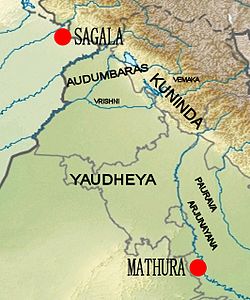Arjunayanas | |||||||
|---|---|---|---|---|---|---|---|
| 2nd century BCE–6th century | |||||||
Location on the Arjunayanas and contemporary South Asian polities circa 150 CE.[1] | |||||||
 | |||||||
| Government | monarchy | ||||||
| History | |||||||
• Established | 2nd century BCE | ||||||
• Disestablished | 6th century | ||||||
| |||||||
| Today part of | India | ||||||
Arjunayana, Arjunavana, Arjunavayana[2][3] or Arjunayanaka was an ancient republican people located in Punjab or north-eastern Rajasthan. They emerged as a political power during the Shunga period (c. 185 – c. 73 BCE). In the Allahabad Pillar Inscription of Samudragupta (c. 335 – c. 380 CE), the Arjunayanas figure among the autonomous political communities bordering on the Gupta Empire who accepted the overlordship of Samudragupta. They are also mentioned in Bṛhat Saṃhitā of Varahamihira (6th century CE).[4][5] According to Dr Buddha Prakash, the Arjunayanas are mentioned as Prajjunakas in Kautiliya's text Arthashastra[5] which also places them in the northern division of India.[6][7] Vincent Smith locates their republic in Alwar and Bharatpur states now in Rajasthan, a view which has been rejected by R. C. Majumdar. They are mentioned in the literary sources in Afghanistan from 4th century BCE and after Alexander's invasions in 3rd century they have been mentioned in Agra, Mathura and Southern Haryana region till 4th century CE where their coins have been found too.
- ^ Schwartzberg, Joseph E. (1978). A Historical atlas of South Asia. Chicago: University of Chicago Press. p. 145, map XIV.1 (d). ISBN 0226742210.
- ^ Journal of Ancient Indian History,1972, p 318, University of Calcutta. Dept. of Ancient Indian History and Culture, Editor D. C. Sircar.
- ^ For Arjunavana = Arjunayan, see: Ancient Indian folk cults, 1970, p 178, Vasudeva Sharana Agrawala.
- ^ VarAhamihira's Brhatsamhita, v 4.25ab; v 11.59cd; v 14.25ab; v 16.21cd; v 17.19cd.
- ^ a b Evolution of Heroic Tradition in Ancient Punjab, 1971, p 110, Buddha Prakash.
- ^ VarAhamihira's Brhatsamhita, v 14.24ab-14.25ab.
- ^ India as seen in the Brhat samhita of Varaha-Mihira, 1969, p 68, A. M. Shastri.
© MMXXIII Rich X Search. We shall prevail. All rights reserved. Rich X Search

